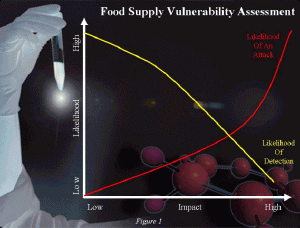So what is at stake? Here are some interesting statistics about the food supply-chain in the United States.These are just from just the Mid-Atlantic region.
Mid-Atlantic Food Supply
- Number of farms = over 100,000
- Number of post-farm businesses = nearly 150,000
- Private Sector Food Business = over 12% of private sector businesses involve food
- Collective Sales = over $300 billion
- Employment = nearly 12% of the workforce
1) The use of food or water as a delivery mechanism for pathogens, chemicals, and/or other harmful substances for the purpose of causing human illness or death.
2) The introduction of anti-crop or anti-livestock agents into agricultural systems.
3) The physical disruption of the flow of food/water as a result of the destruction of transportation or other vital infrastructure.
So how vulnerable is our food supply? That is a question that has been asked by scientists and government officials.The answer lies in an analysis of the "food" supply-chain.The supply chain begins with a vast number of producers (farms) and the numerous transportation, processing and distribution facilities that are all part of bringing the food to the point of consumption.It is estimated that 98 percent of all U.S.farms are family farms.This small, highly distributed food production network creates security, monitoring and tracking challenges. Very large factory farms make up only 3 percent of the total farms but contribute more than 40 percent of the output.In addition to being vulnerable to terrorist attacks, this system makes it exceedingly difficult to trace back and identify the source of the contaminated food.
Figure 1 examines the likelihood of a bioterrorism attack against the U.S.food supply and the impact of such an attack.Four recent GAO reports found gaps in federal controls for protecting agriculture and the food supply.Local, state and federal officials must do even more to protect our food supply from tampering. A new comprehensive approach is needed if we are to safeguard our food supply.
- Document the "food" supply-chain
- Analyze risks and vulnerabilities
- Identify critical control points
- Establish monitoring procedures
- Develop response plan
- Develop reporting and tracking system
- Develop system reliability checks
Exempt from these regulations are the transportation vehicles that hold food only in the usual course of business.As you could imagine the ability to attack our food supply while in transit from the production site is a critical area and possibly the area that has the least amount of protection currently.It is important to recognize that this is only one of many exceptions granted under the act.
Protecting U.S.agriculture and ensuring safe and wholesome meat and poultry is one of the primary challenges facing USDA.The office of the Inspector General of the United States Department of Agriculture's chief missions is to ensure the safety of the food supply, both by auditing food safety programs to detect deficiencies and recommend improvements and by investigating criminal activity involving the intentional contamination of food products.They also monitor the processing and sale of adulterated meat, poultry, and egg products; and the substitution, adulteration or other misrepresentation of food products regulated or inspected by USDA.
Technology
The Department of Homeland
Security in June 2004 announced the first Designations and Certifications
under the Support Anti-terrorism by Fostering Effective Technologies (SAFETY)
Act.The SAFETY Act provides liability limitations for makers and sellers
of qualified anti-terrorism technologies, including those that may be used
to protect the nation's food supply.DHS is also developing a new National
Biodefense Analysis and Countermeasures Center (NBACC) to support the law
enforcement and intelligence communities in their biodefense responsibilities.
The Center will apply the newest advances in science to the challenges
both of biological threat characterization and of bioforensics, strengthening
the nation's ability to determine the source of a biological agent used
in an attack and strengthening deterrence.In June 2004, DHS announced
its new Regional Technology Integration (RTI) initiative.RTI provides
a mechanism for working directly with urban areas on infrastructure protection
(including protection of the food supply) to develop and deliver new technologies
as part of a regional security response.The program focuses on regional
collaboration, private sector solutions, measurable objectives and continuous
evaluation, and communicating best practices and lessons learned to other
communities, states, Congress, the Administration, and other federal agencies.
The support is there.Now all that is needed is a workable platform that can provide an economically feasible solution to safeguarding our food supply.A critical component of this platform will, without question, be a GIS system that supports tracking and traceability.Incorporated into the platform will also be RFID capabilities to trace the product throughout the food supply-chain. These hybrid tags will also serve to detect tampering and integrated with new biosensors will alert food processors to possible contaminates.But this platform will not be cheap.The question is can the platform be developed and implemented in time to protect the population from a bioterrorist attack against our food supply? Only time will answer that question.
Conclusion
The food supply is by far
the most vulnerable to a bioterrorism attack.This year we learned from
news reports that terrorists have developed materials to manufacture salmonella
and botulinum, and they may have intended to poison the food supply.Even
more alarming was a Washington Post article on biological weapons
developed by the South African government under the apartheid regime, including
a biological agent created by splicing a common strain of E.coli with
a toxin-producing gene from Clostridium perfringens.These are only a handful
of examples of food bioterrorism that demonstrate the health and economic
damage that could be inflicted through an attack on the food supply.
We need to continue to strengthen
our food supply surveillance systems and improve communication and coordination
among local, state and federal agencies to heighten the ability to recognize
and quickly respond to food-borne outbreaks.This will not be cheap or
able to be accomplished in a short period of time.
